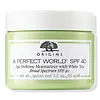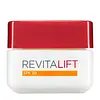What's inside
What's inside
 Key Ingredients
Key Ingredients

 Benefits
Benefits

 Concerns
Concerns

 Ingredients Side-by-side
Ingredients Side-by-side

Butyl Methoxydibenzoylmethane 3%
UV AbsorberHomosalate 8%
Skin ConditioningEthylhexyl Methoxycinnamate 7.5%
UV AbsorberEthylhexyl Salicylate 4.5%
UV AbsorberOctocrylene 5%
UV AbsorberWater
Skin ConditioningButylene Glycol
HumectantGlycerin
HumectantAmmonium Acryloyldimethyltaurate/Vp Copolymer
Polyethylene
AbrasiveCitrus Aurantium Bergamia Fruit Oil
MaskingCitrus Limon Peel Oil
MaskingCitrus Aurantium Dulcis Oil
MaskingCinnamomum Camphora Bark Oil
MaskingMentha Viridis Leaf Oil
AstringentMagnolia Acuminata Flower Extract
Skin ConditioningIris Pallida Root Extract
MaskingRosa Damascena Extract
MaskingCitral
PerfumingLinalool
PerfumingLimonene
PerfumingCetyl Alcohol
EmollientGlyceryl Stearate
EmollientPEG-100 Stearate
PEG-6
HumectantVaccinium Angustifolium Fruit Extract
Skin ProtectingVaccinium Macrocarpon Fruit Extract
AstringentSolanum Tuberosum Pulp Extract
SmoothingLycium Chinense Fruit Extract
AntioxidantEriobotrya Japonica Leaf Extract
Skin ConditioningPassiflora Incarnata Flower Extract
Skin ConditioningLeontopodium Alpinum Extract
Skin ConditioningBetula Alba Bark Extract
MaskingCamellia Sinensis Leaf Extract
AntimicrobialBoswellia Serrata Extract
Skin ConditioningSigesbeckia Orientalis Extract
Skin ConditioningThermus Thermophillus Ferment
Skin ConditioningHordeum Vulgare Extract
EmollientTriticum Vulgare Germ Extract
Skin ConditioningSaccharomyces Lysate Extract
HumectantLythrum Salicaria Extract
AstringentYeast Extract
Skin ConditioningAlgae Extract
EmollientOryzanol
Skin ConditioningSqualane
EmollientEthylhexylglycerin
Skin ConditioningTrehalose
HumectantSteareth-21
CleansingErgothioneine
AntioxidantSodium Hyaluronate
HumectantVp/Eicosene Copolymer
Nylon-12
Caprylyl Glycol
EmollientSodium PCA
HumectantSodium Dehydroacetate
PreservativeTocopheryl Acetate
AntioxidantUrea
BufferingAscorbyl Tocopheryl Maleate
AntioxidantCitric Acid
BufferingPolyquaternium-51
Skin ConditioningHexylene Glycol
EmulsifyingLecithin
EmollientSodium Phytate
BHT
AntioxidantMica
Cosmetic ColorantPhenoxyethanol
PreservativeButyl Methoxydibenzoylmethane 3%, Homosalate 8%, Ethylhexyl Methoxycinnamate 7.5%, Ethylhexyl Salicylate 4.5%, Octocrylene 5%, Water, Butylene Glycol, Glycerin, Ammonium Acryloyldimethyltaurate/Vp Copolymer, Polyethylene, Citrus Aurantium Bergamia Fruit Oil, Citrus Limon Peel Oil, Citrus Aurantium Dulcis Oil, Cinnamomum Camphora Bark Oil, Mentha Viridis Leaf Oil, Magnolia Acuminata Flower Extract, Iris Pallida Root Extract, Rosa Damascena Extract, Citral, Linalool, Limonene, Cetyl Alcohol, Glyceryl Stearate, PEG-100 Stearate, PEG-6, Vaccinium Angustifolium Fruit Extract, Vaccinium Macrocarpon Fruit Extract, Solanum Tuberosum Pulp Extract, Lycium Chinense Fruit Extract, Eriobotrya Japonica Leaf Extract, Passiflora Incarnata Flower Extract, Leontopodium Alpinum Extract, Betula Alba Bark Extract, Camellia Sinensis Leaf Extract, Boswellia Serrata Extract, Sigesbeckia Orientalis Extract, Thermus Thermophillus Ferment, Hordeum Vulgare Extract, Triticum Vulgare Germ Extract, Saccharomyces Lysate Extract, Lythrum Salicaria Extract, Yeast Extract, Algae Extract, Oryzanol, Squalane, Ethylhexylglycerin, Trehalose, Steareth-21, Ergothioneine, Sodium Hyaluronate, Vp/Eicosene Copolymer, Nylon-12, Caprylyl Glycol, Sodium PCA, Sodium Dehydroacetate, Tocopheryl Acetate, Urea, Ascorbyl Tocopheryl Maleate, Citric Acid, Polyquaternium-51, Hexylene Glycol, Lecithin, Sodium Phytate, BHT, Mica, Phenoxyethanol
Water
Skin ConditioningGlycerin
HumectantEthylhexyl Salicylate
UV AbsorberDimethicone
EmollientAlcohol Denat.
AntimicrobialOctocrylene
UV AbsorberNylon-12
Butyl Methoxydibenzoylmethane
UV AbsorberOctyldodecanol
EmollientPhenylbenzimidazole Sulfonic Acid
UV AbsorberCetyl Alcohol
EmollientBehenyl Alcohol
EmollientTriethanolamine
BufferingIsopropyl Isostearate
EmollientHydrolyzed Soy Protein
HumectantAcetyl Trifluoromethylphenyl Valylglycine
Skin ConditioningAdenosine
Skin ConditioningCapryloyl Salicylic Acid
ExfoliatingDisodium EDTA
Faex Extract
Skin ConditioningSalicyloyl Phytosphingosine
Skin ConditioningRetinyl Palmitate
Skin ConditioningAcrylamide/Sodium Acryloyldimethyltaurate Copolymer
Emulsion StabilisingAluminum Starch Octenylsuccinate
AbsorbentAmmonium Polyacryloyldimethyl Taurate
Emulsion StabilisingCetearyl Alcohol
EmollientCetearyl Glucoside
EmulsifyingDisodium Stearoyl Glutamate
CleansingHydroxyethyl Acrylate/Sodium Acryloyldimethyl Taurate Copolymer
Emulsion StabilisingIsohexadecane
EmollientMyristic Acid
CleansingPalmitic Acid
EmollientPEG-100 Stearate
Pentylene Glycol
Skin ConditioningPoly C10-30 Alkyl Acrylate
Emulsion StabilisingPolyethylene
AbrasivePolysorbate 60
EmulsifyingPolysorbate 80
EmulsifyingSorbitan Isostearate
EmulsifyingSorbitan Oleate
EmulsifyingStearic Acid
CleansingSilica
AbrasiveTitanium Dioxide
Cosmetic ColorantAlpha-Isomethyl Ionone
PerfumingBenzyl Alcohol
PerfumingBenzyl Salicylate
PerfumingCitronellol
PerfumingGeraniol
PerfumingHexyl Cinnamal
PerfumingLimonene
PerfumingLinalool
PerfumingCI 15510
Cosmetic ColorantPhenoxyethanol
PreservativeTocopherol
AntioxidantParfum
MaskingWater, Glycerin, Ethylhexyl Salicylate, Dimethicone, Alcohol Denat., Octocrylene, Nylon-12, Butyl Methoxydibenzoylmethane, Octyldodecanol, Phenylbenzimidazole Sulfonic Acid, Cetyl Alcohol, Behenyl Alcohol, Triethanolamine, Isopropyl Isostearate, Hydrolyzed Soy Protein, Acetyl Trifluoromethylphenyl Valylglycine, Adenosine, Capryloyl Salicylic Acid, Disodium EDTA, Faex Extract, Salicyloyl Phytosphingosine, Retinyl Palmitate, Acrylamide/Sodium Acryloyldimethyltaurate Copolymer, Aluminum Starch Octenylsuccinate, Ammonium Polyacryloyldimethyl Taurate, Cetearyl Alcohol, Cetearyl Glucoside, Disodium Stearoyl Glutamate, Hydroxyethyl Acrylate/Sodium Acryloyldimethyl Taurate Copolymer, Isohexadecane, Myristic Acid, Palmitic Acid, PEG-100 Stearate, Pentylene Glycol, Poly C10-30 Alkyl Acrylate, Polyethylene, Polysorbate 60, Polysorbate 80, Sorbitan Isostearate, Sorbitan Oleate, Stearic Acid, Silica, Titanium Dioxide, Alpha-Isomethyl Ionone, Benzyl Alcohol, Benzyl Salicylate, Citronellol, Geraniol, Hexyl Cinnamal, Limonene, Linalool, CI 15510, Phenoxyethanol, Tocopherol, Parfum
 Reviews
Reviews

Ingredients Explained
These ingredients are found in both products.
Ingredients higher up in an ingredient list are typically present in a larger amount.
Also known as Avobenzone, this ingredient is a chemical sunscreen filter that provides protection in the UV-A range.
Avobenzone is globally approved and is the most commonly used UV-A filter in the world.
Studies have found that avobenzone becomes ineffective when exposed to UV light (it is not photostable; meaning that it breaks down in sunlight). Because of this, formulations that include avobenzone will usually contain stabilizers such as octocrylene.
However, some modern formulations (looking at you, EU!) are able to stabilize avobenzone by coating the molecules.
Avobenzone does not protect against the UV-B range, so it's important to check that the sunscreen you're using contains other UV filters that do!
The highest concentration of avobenzone permitted is 3% in the US, and 5% in the EU.
Learn more about Butyl MethoxydibenzoylmethaneCetyl Alcohol is a fatty alcohol. Fatty Alcohols are most often used as an emollient or to thicken a product.
Its main roles are:
Though it has "alcohol" in the name, it is not related to denatured alcohol or ethyl alcohol.
The FDA allows products labeled "alcohol-free" to have fatty alcohols.
Learn more about Cetyl AlcoholEthylhexyl Salicylate is an organic compound used to block UV rays. It primarily absorbs UVB rays but offers a small amount of UVA protection as well.
Commonly found in sunscreens, Ethylhexyl Salicylate is created from salicylic acid and 2-ethylhexanol. You might know salicylic acid as the effective acne fighter ingredient and BHA.
The ethylhexanol in this ingredient is a fatty alcohol and helps hydrate your skin, similar to oils. It is an emollient, which means it traps moisture into the skin.
According to manufacturers, Ethylhexyl Salicylate absorbs UV wavelength of 295-315 nm, with a peak absorption at 307-310 nm. UVA rays are linked to long term skin damage, such as hyperpigmentation. UVB rays emit more energy and are capable of damaging our DNA. UVB rays cause sunburn.
Learn more about Ethylhexyl SalicylateGlycerin is already naturally found in your skin. It helps moisturize and protect your skin.
A study from 2016 found glycerin to be more effective as a humectant than AHAs and hyaluronic acid.
As a humectant, it helps the skin stay hydrated by pulling moisture to your skin. The low molecular weight of glycerin allows it to pull moisture into the deeper layers of your skin.
Hydrated skin improves your skin barrier; Your skin barrier helps protect against irritants and bacteria.
Glycerin has also been found to have antimicrobial and antiviral properties. Due to these properties, glycerin is often used in wound and burn treatments.
In cosmetics, glycerin is usually derived from plants such as soybean or palm. However, it can also be sourced from animals, such as tallow or animal fat.
This ingredient is organic, colorless, odorless, and non-toxic.
Glycerin is the name for this ingredient in American English. British English uses Glycerol/Glycerine.
Learn more about GlycerinLimonene is a fragrance that adds scent and taste to a formulation.
It's found in the peel oil of citrus fruits and other plants such as lavender and eucalyptus. The scent of limonene is generally described as "sweet citrus".
Limonene acts as an antioxidant, meaning it helps neutralize free radicals.
When exposed to air, oxidized limonene may sensitize the skin. Because of this, limonene is often avoided by people with sensitive skin.
The term 'fragrance' is not regulated in many countries. In many cases, it is up to the brand to define this term. For instance, many brands choose to label themselves as "fragrance-free" because they are not using synthetic fragrances. However, their products may still contain ingredients such as essential oils that are considered a fragrance.
Learn more about LimoneneLinalool is a fragrance and helps add scent to products. It's derived from common plants such as cinnamon, mint, citrus, and lavender.
Like Limonene, this ingredient oxidizes when exposed to air. Oxidized linalool can cause allergies and skin sensitivity.
This ingredient has a scent that is floral, spicy tropical, and citrus-like.
Learn more about LinaloolNylon-12 is a polymer. It is derived from 12-aminododecanoic acid, an omega-amino fatty acid
According to a manufacturer, it is a talc substitute. Like talc, nylon-12 gives products a satin feel. The manufacturer also claims this ingredients does not block pores and has moderate oil absorption.
This ingredient may not be reef-safe.
Learn more about Nylon-12Octocrylene protects skin from sun damage. It absorbs UV-B with peak absorption of 304 nm. It is a common sunscreen ingredient and often paired with avobenzone, a UVA filter. This is because octocrylene stabilizes other sunscreen ingredients by protecting them from degradation when exposed to sunlight. Octocrylene is a photostable ingredient and loses about 10% of SPF in 95 minutes.
Octocrylene also acts as an emollient, meaning it helps skin retain moisture and softens skin. It is oil-soluble and hydrophobic, enhancing water-resistant properties in a product.
Those who are using ketoprofen, a topical anti-inflammatory drug, may experience an allergic reaction when using octocrylene. It is best to speak with a healthcare professional about using sunscreens with octocrylene.
The EU allows a maximum of these concentrations:
Learn more about OctocrylenePeg-100 Stearate is an emollient and emulsifier. As an emollient, it helps keep skin soft by trapping moisture in. On the other hand, emulsifiers help prevent oil and water from separating in a product.
PEGS are a hydrophilic polyether compound . There are 100 ethylene oxide monomers in Peg-100 Stearate. Peg-100 Stearate is polyethylene glycol ester of stearic acid.
Phenoxyethanol is a preservative that has germicide, antimicrobial, and aromatic properties. Studies show that phenoxyethanol can prevent microbial growth. By itself, it has a scent that is similar to that of a rose.
It's often used in formulations along with Caprylyl Glycol to preserve the shelf life of products.
Polyethylene is a synthetic ingredient that helps the skin retain moisture. It is a polymer.
It is also typically used within product formulations to help bind solid ingredients together and thicken oil-based ingredients. When added to balms and emulsions, it helps increase the melting point temperature.
Water. It's the most common cosmetic ingredient of all. You'll usually see it at the top of ingredient lists, meaning that it makes up the largest part of the product.
So why is it so popular? Water most often acts as a solvent - this means that it helps dissolve other ingredients into the formulation.
You'll also recognize water as that liquid we all need to stay alive. If you see this, drink a glass of water. Stay hydrated!
Learn more about Water